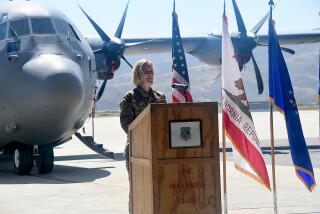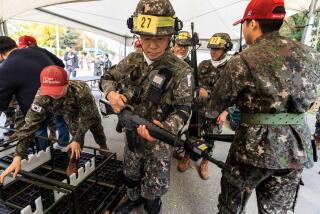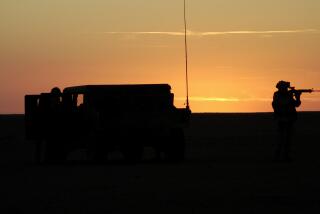National Guard Readies for Iraq
FT. IRWIN, Calif. — Weekend warriors no more, the stockbroker, the motorcycle cop and the carpenter were undergoing intense training last week for their new mission as part of an occupation army in Iraq.
They were busy cordoning off villages, detecting homemade bombs, negotiating with Muslim religious leaders, enduring anti-American taunts from hostile crowds and engaging in other military exercises here at the Army’s National Training Center in the Mojave Desert.
The three Californians -- Palm Desert stockbroker Barry Sayers, Fresno Police Officer Robert Espinoza and Hemet carpenter Mark Reed -- are part of the biggest rotation of National Guard forces into a foreign combat zone since the Korean War. Several thousand National Guard soldiers assigned to the 81st Armor Brigade are training at Ft. Irwin until mid-March, when they will ship out to Iraq.
By April 15, Pentagon officials say, about 40% of the 110,000-plus U.S. force in Iraq will be National Guard members or reservists. They leave behind family and jobs for perilous overseas duties not performed by American soldiers since the occupations of Japan and Germany after World War II.
In Iraq, the National Guard’s mission is to provide security until the Iraqi military and police can do it on their own. Although the Bush administration has pledged to turn over political control in Iraq by the end of June, the National Guard assignment, which includes a total of 2,000 troops from California, half of whom are already in Iraq, is scheduled to last at least until spring 2005.
In a training exercise last week, Sayers got a taste of the frustration that may lie ahead as he stood atop a Ft. Irwin hill watching soldiers under his command get ensnared by a mob posing as angry Iraqis. Lt. Col. Sayers is commander of the 600-soldier 1st Battalion, 185th Armor Regiment headquartered in San Bernardino.
The exercise was designed to teach the soldiers how to surround an Iraqi village and search for hidden weapons. The unit’s first attempt at this failed.
Some of Sayers’ 185th guardsmen appeared more prepared than others.
Reed, 45, a father of four, marveled at the idea of crossing oceans to a foreign land.
“I’ve been to Catalina; that’s as far out to sea as I’ve been,” said Reed, a sergeant. Before this, he said, his main duties during his 11-year stint in the National Guard have been to help fight California forest fires.
For others, like Espinoza, also 45 and a father of four, both the destination and the assignment will be more familiar.
Sgt. 1st Class Espinoza is a former Green Beret who once served as an anti-terrorist advisor to the Jordanian army. Perhaps more relevant to the Iraq situation, Espinoza said, is that, as a member of the Fresno police SWAT team, he has participated in 433 searches involving drugs and heavily armed gangs.
“There are a lot of similarities with what we are doing now,” Espinoza said.
He represents what National Guard chief Lt. Gen. H. Steven Blum sees as the Guard’s edge over regular forces.
“This is a situation,” Blum said, “where I think the Guard may have some operational advantages. Some of them are cops. Some of them may have done riot duty. They get extra leverage from these civilian activities.”
Less optimistic, retired Army Col. David Hackworth, a decorated veteran and military commentator, fears that the National Guard deployment is a potential nightmare for Secretary of Defense Donald H. Rumsfeld, who came up with the plan to use the Guard and reserves as a “sustaining force” in the U.S. occupation.
Hackworth said his sources in the military tell him that none of three National Guard brigades being deployed to Iraq, including the 81st, has performed well so far in training. Part of the problem, Hackworth said, is that, besides being asked to replace experienced regular units, the soldiers of the 81st also are being converted from armored units to motorized infantry to conform to the needs of the occupation force.
“It’s like telling the Lakers that they are not going to play basketball but are now going to be Ping-Pong champs. I hope I am totally wrong, but my gut tells me we are in a world of trouble and the result is going to be more body bags.”
Troops Generally Older
Compared with their counterparts in the regular Army, National Guard soldiers are generally older, have larger families, and are more engaged in their home communities and economies. If something happens to them, their losses will weigh heavily at home. The ballot box can become an outlet for grief.
For that reason, President Lyndon B. Johnson was reluctant to mobilize the National Guard for service during the Vietnam War. As a result, only a relative handful of guard personnel participated. “LBJ didn’t want to bring the war home to every locality by bringing in the Guard,” Hackworth said. “Ironically, that’s what happened anyway, when he used the draft. I don’t think the Bush administration has thought out the lessons of LBJ.”
Some citizen soldiers, however, are eager to ship out.
Former Visalia, Calif., grocery chain executive Gregory Shirk, 44, had comfortably retired when he joined the guard 11 years ago seeking adventure and public service. He was on his cot at Ft. Irwin on a recent evening happily watching a DVD of “Lawrence of Arabia,” which he said he had already viewed countless times.
One of Spc. Shirk’s superior officers is 28-year-old Demetrius Myers, who in civilian life is a Wal-Mart delivery dock supervisor in Ontario. Myers, who served four years in the Army before joining the Guard, said he was thrilled about going to Iraq but concerned about the toll it would take on his young wife and 4-month-old daughter.
“My wife is a little worried,” Myers said. “I hope we can work through it.” Financially, he said, he will be in better shape, as the overseas combat pay will more than cover what he makes at Wal-Mart.
For Ft. Irwin, the training represents a dramatic shift from the Army post’s historical role as the venue for massive war games involving heavy artillery and battle tanks to the new military challenge of “asymmetrical, full-spectrum, unpredictable” urban warfare against a highly mobile, irregular foe. Although similar training programs were set up for troops assigned to peacekeeping duties in Bosnia and Kosovo, those were not nearly on the same large scale as the one launched here last month.
‘Villages’ in Landscape
The sprawling base in the high desert northeast of Barstow has been converted into a mock Iraqi landscape with six Arabic-named “villages,” networks of caves, opposing teams of hostile insurgents and 100 Iraqi Americans hired to lend realism to the exercises for the 4,000-member National Guard brigade currently in training.
Jay Mussa, 48, an Iraqi American car salesman from San Diego, plays the role of a village official the Guard troops are supposed to negotiate with and win over to the American side.
“It’s about communication,” said Mussa, a Shiite Muslim and Baghdad native who has lived in the United States for 23 years. “Some people do not understand when American troops tell them to put their hands up or lie down. Some of our own American kids have died for lack of communication.”
Maj. Jack Vantress, the training center’s briefing officer, said: “We are here to train these soldiers against an enemy that has capabilities ranging from a single cellphone to chemical weapons.”
On a projection screen in the center’s briefing room, Vantress pointed to a list of possible encounters for the troops: “NGOs [nongovernmental organizations], Extremists, Terrorists, Civilian Powers, Local Leaders.” Before these exercises, Vantress said, many of the officers and troops had “never heard of an NGO.”
Among the battlefield scenarios set up for the National Guard troops are convoy ambushes, midnight bomb attacks and terrorist hostage situations.
One exercise, Vantress said, involves a United Nations bus with 30 passengers, including two pregnant women, a wounded insurgent and a pair of terrorists strapped with bombs. Another involves a suspicious foreign reporter who shows up unexpectedly at camp asking questions.
From his hilltop vantage point, Sayers, the stockbroker-battalion commander, watched as his convoy of Humvees made a second run at the mock Iraqi village that troops had been ordered to search for a cache of weapons.
Before the Iraq assignment, Sayers worked for A.G. Edwards & Sons Inc. Confronting Iraqi insurgents, he joked, might be “less hostile” than dealing with stockholders who have lost money.
Below him in the village made from shipping containers were several dozen civilians -- including Mussa and other Iraqi Americans -- posing as hostile townspeople and chanting anti-American slogans.
The unit’s first attempt to surround the village and find the weapons had gone poorly because the soldiers had failed to keep a safe distance between themselves and the angry civilians.
“The inner cordon was too close and got mixed up with the population,” said National Training Center commander Brig. Gen. Joseph Fil Jr., one of three generals who was observing the operation. The training center’s job, Fil said, is to “create chaos down there that is even worse than what they will see in Iraq.”
On their second try, the soldiers again were unable to control the crowd.
Sayers and his battalion were getting a preview of what might await them at the end of March.
‘You Broke Our Homes!’
“You broke our homes! You are killing unarmed Iraqi people!” the milling crowd chanted in the faces of the advancing American troops.
Again, the effort to calm and control the village failed. Several U.S. soldiers were cut off from their comrades. An attempt to negotiate with the village “mayor” broke down. A civilian was apparently wounded.
“They were supposed to come in and co-opt the mayor,” explained Lt. Col. Greg Watt, one of the center’s observers. “It was set up so that, if they did this, then it was possible to succeed. They didn’t, and now they are in consequence management.”
Down in the village, the crowd continued to chant.
“We are peaceful citizens,” members of the crowd shouted in Arabic and English as smoke from a makeshift bomb swirled in the village courtyard. “Go home!”
More to Read
Sign up for Essential California
The most important California stories and recommendations in your inbox every morning.
You may occasionally receive promotional content from the Los Angeles Times.










